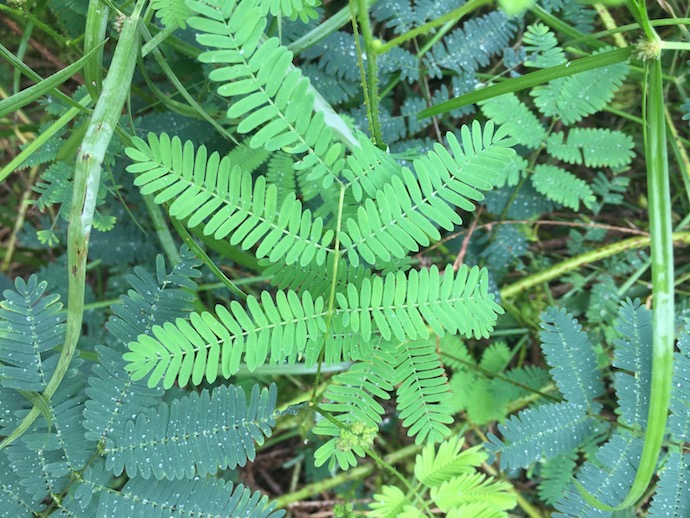 Can plants behave? Can they weigh risk against reward? Do they have personalities? A new study suggests they can and do—and that we’ve missed their complex behavior in part because they live life at such a different pace.
Can plants behave? Can they weigh risk against reward? Do they have personalities? A new study suggests they can and do—and that we’ve missed their complex behavior in part because they live life at such a different pace.
Mimosa pudica, or “sensitive plant” is a frilly plant in the pea family with a wonderful talent—when touched, its leaflets fold up, demurely and rather sedately (but fast as all-get-out by plant standards) as if to say “I’m too proud and reserved to be eaten.”
The plant, despite its rather refined air, has weedy proclivities and has naturalized across the tropics, so its party trick must be adaptive. But the “touch-me-not”, as it is also called, has to do a bit of cost benefit analysis when deploying its rapid-fire defensive mode. You see, although closing the leaves reduces the area available to munching herbivores like insects, it also reduces photosynthesis by about 40%. Much like an animal that cannot forage or hunt for food while it is hiding, the plant can’t eat while it is tucked away. So how does it decide how long to keep those lovely bipinnate leaves hidden?
https://www.youtube.com/watch?v=C0gVInrybas
A clever experiment to answer this was done by Evelyn Jensen, Lawrence Dill, and James Cahill in a paper from 2011. They found that Mimosa in lower light environments opened their leaflets sooner, willing to risk predation to get some of that golden sunshine (or whatever passes for sunshine in when swathed in shade cloth in “a south-facing room in the greenhouses of the Department of Biological Sciences at the University of Alberta”).
Two new studies take the questions further. In one, published last year in Ecology and Evolution, Franz Simon at Yale, Christina Hodson at University of Victoria, and Bernard Roitberg at Simon Fraser University investigated whether the “energy state” of the plant—basically whether it was starving or not—also affected opening time. Like a ragged, desperate elk brazenly munching aspen in full view of a pack of wolves, famished plants barely bothered to close up when touched.
In addition, plants from two different nurseries tended do the calculation differently—suggesting that there is such a thing as plant culture. The Mimosa from Stokes Seeds consistently opened faster than those from Page’s Seeds, suggesting that “a plant’s genetic background may influence its behavior,” according to the study.
But this team didn’t find consistent individual differences between plants. Perhaps, they speculated, that was because “we raised plants in an environment lacking social interaction, and as much as possible removed any environmental variation between individuals during development.” Little isolated clones in greenhouse pots—the poor things could hardly have anything to hang a personality on. After all, as the team wrote, “Organisms are more likely to have individual repeated differences if they experience consistent microhabitats and long-term social interactions.”
Now, another group–Daniel Blumstein of the University of California, Los Angeles and three students, all recently graduated:Sarah Reed-Guy, Connor Gehris, Meng Shi–has taken the investigation into the wilds of Mo’orea, a paradisal island in French Polynesia, just a quick boat ride from Tahiti. This team recorded the amount of time each individual plant stayed closed after being touched. These wild Mimosa, with plenty of environmental variation and social interaction, showed consistent and repeatable differences in leaflet costing time. There were the risk-averse and the sun-gluttons among them. One little plant was not the same as the next.
Then the team starved some plants by putting black garbage bags over them. (They put clear garbage bags over the others as a control so that the physical touch of the bags would be constant.) As expected, hungry plants re-opened their leaves faster after being touched, but the effect of individual personalty was still important. The risk-averse didn’t have their personality obliterated by hunger. The sun gluttons remained greedy. As they note in the last line of their paper: “Plants, it seems, may have personality.”
Mimosa are the perfect model system to investigate these questions in plants because it is one of the cases where flora deign to behave on the timescale of us fauna. Trapped in our own fast-forward world, it is hard for us to see plants making tradeoffs, calculating risk, and expressing personalities.
“The timeframes of many plant behaviors is different than many animals,” says Blumstein, who spends most of his time studying animal behavior. “You have to squint.”
Coupled with recent discoveries in tree-to-tree communication, tree shyness, and even cooperation, the Mimosa research suggests that we should not overlook or underestimate the plants of this world. Apart from making the oxygen you breathe and providing the basis for the food web upon which you depend, plants may also be basically as smart as you are—just less hasty.
Very interesting article. I have no problem with plant-to-plant communication, tree shyness, or cooperation, but to call that social interaction goes way too far. They are exchanging chemicals not opinions, and they don’t have a choice of whether or not to communicate, be shy, or cooperate. Yes, there are differences between plants within species and plant interactions are complex, but we should not anthropomorphize them.
Delightful! Especially the final line’s nod to that famous fictional flora sapiens, Treebeard, and his motto “Don’t be hasty.”